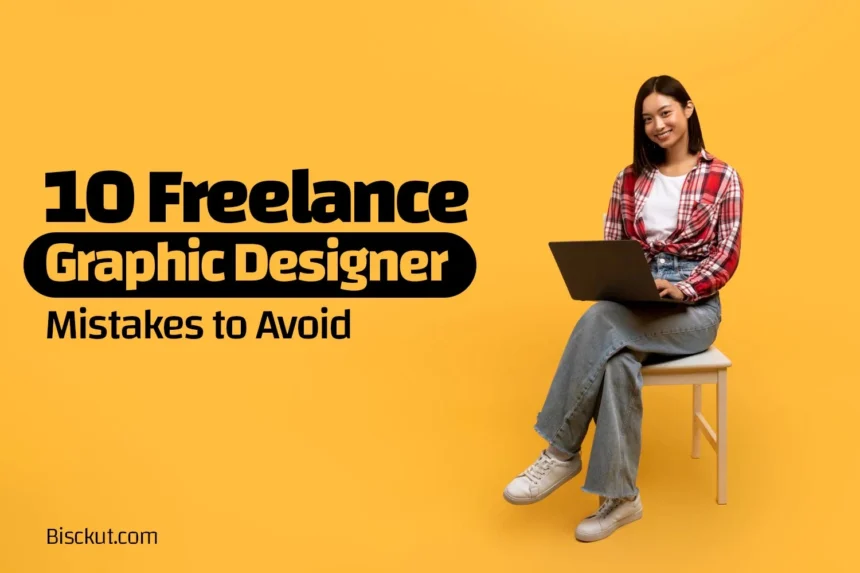Freelancing as a graphic designer often feels like a dream — creative freedom, flexible hours, and being your own boss. But even a dream job has its pitfalls. Many new and mid‑level freelancers fall into hidden traps like underpricing work or skipping contracts, which can quietly sabotage your success. This guide explores freelance graphic designer mistakes that hold back growth, especially when it comes to client relationships, portfolio building, and pricing your services right. You’ll learn how to avoid these common errors through expert advice and real-world examples — so you can build a more sustainable, profitable design career. Let’s dive in.

1. Undervaluing Your Work (Setting Rates Too Low)
You might think dropping your rates will land you more clients, but it often sends the wrong message. In fact, charging too little for high-quality work is a classic rookie mistake. Clients often equate price with value – if your rate is suspiciously low, they may assume your work lacks quality. Worse, low rates attract bargain-hunters who’ll nickel-and-dime you later on.
To stop the underpricing trap:
- Research market rates. Check industry benchmarks (Glassdoor, design surveys, freelance platforms) to see what designers with your experience charge. This helps you set competitive rates instead of guessing.
- Calculate your needs. Figure out an hourly rate that covers your living costs, business expenses, and time off. Remember you’re not just selling pixels – you’re selling strategy and expertise.
- Package your services. Offer tiered bundles (Basic/Pro/Premium) or project quotes rather than open-ended hourly projects. Packages give clients clarity and prevent endless revisions over minor scope creep.
- Raise rates as you grow. Don’t stay stuck at beginner pricing. If you win every quote you send, it’s a sign your rates are too low. Treat each project as a chance to justify a slight increase and charge what you’re truly worth.
By valuing yourself properly from the start, you’ll attract clients who respect your work – and you’ll earn more without working extra hours.
2. Skipping the Contract (No Clear Agreement)
Working without a contract is a fast track to stress and wasted time. Imagine you finish a logo design and then have to chase the client for weeks to get paid – that happens when there was no contract in place. A clear agreement protects you and sets expectations from day one. As one expert puts it, “nothing kills a client relationship faster than misaligned deliverables, timelines, or payments”.
Make it a non-negotiable rule: always sign a simple contract before starting work. Your contract (even a one-page email agreement) should cover at least: scope of work, payment terms (including deposit and due dates), number of revisions, timeline/milestones, and a cancellation clause. You can reuse a template for every client to save time.
- Get a deposit upfront. A 30–50% upfront payment ensures the client is invested.
- Define scope precisely. List exactly what you will (and won’t) do. If the client asks for extra work beyond the agreement, either adjust the scope or charge more.
- Set payment terms. State when invoices are due and what happens if they’re late.
A contract doesn’t have to be scary legalese – it simply gives you and the client a shared roadmap. Skip this step, and you risk burnout, unhappy clients, and even never getting paid.
3. Saying “Yes” to Everything (Overcommitting)
When you’re new on the scene, it’s tempting to accept every project, deadline, or odd request for fear of losing income. But saying yes to everything is a sure way to crash and burn. Overbooking yourself squeezes your creativity and sanity – one article bluntly warns that “overbooking as a designer…comes at the cost of your sanity and can lead to burnout”.
Learn to set boundaries early. This isn’t about being rude – it’s about managing your workload so each project gets your best effort. Try these tactics:
- Use a calendar or project tool. Visualize your schedule (Trello, Notion, etc.) so you see when you’re free. Don’t book more hours than you have.
- Make a “red flags” list. Note warning signs like unclear briefs, unrealistic deadlines, or ridiculously low pay. If a new request ticks those boxes, be prepared to say no or negotiate terms.
- Polite refusals. You can decline offers respectfully. For example: “Thanks for thinking of me, but my schedule’s full right now” or “This project isn’t the best fit for my expertise.” Clients often respect honesty and will remember you for future work when you’re available.
Saying no sometimes protects your quality of work and your mental health. Remember, clients who respect your boundaries are the ones you want long-term, and turning down bad opportunities leaves space for good ones.
4. Poor Time Management (Chasing Deadlines)
Without a boss or office structure, it’s easy to let tasks pile up. A to-do list as long as your arm is a common struggle, and one blogger notes that “freelance time management mistakes are extremely common – and deadly to your productivity.”. If you habitually miss deadlines or scramble at the last minute, you’ll frustrate clients (and yourself).
Combat this with simple systems:
- Track your time. Use tools like Toggl or Clockify to see where hours go. This data helps you plan better next time.
- Work in focused sprints. Try the Pomodoro Technique (25 minutes on, 5 minutes off). Breaking work into short bursts helps maintain momentum and prevents burnout.
- Block out your week. Allocate specific days or times to client work, admin, marketing, and rest. For example, you might do all design work Monday–Wednesday, then handle emails/invoices on Thursday.
- Batch similar tasks. Group design tasks together and do all client communications at once. This minimizes context-switching.
By managing time like a pro, you deliver reliably and create breathing room for growth and creativity.
5. Weak Communication with Clients
Even if your designs are stellar, poor communication can derail a project. One blog bluntly states: “bad communication can destroy even the best design project”. For instance, you might craft a beautiful package design only to have the client hate it – not because you failed, but because you misunderstood their brief. You assumed certain colors or layout, and the client assumed something else.
Fix this by talking before you start drawing. Make sure you and your client speak the same language:
- Use a client-friendly brief. Ask specific questions up front: Who is the audience? What feelings should the design evoke? What are the must-have elements?
- Summarize key points. After calls or significant emails, send a recap so there’s a written record of decisions (no more “I thought you meant…” surprises).
- Ask clarifying questions. Don’t guess. If anything in the brief is vague, request examples or clarification.
- Regular check-ins. Give the client progress updates (a quick email or message) especially on longer projects. This builds trust and catches misunderstandings early.
- Be transparent about delays. If something takes longer than planned, let the client know ASAP. They’d rather adjust a timeline than be left hanging.
Clear communication means fewer revisions and happier clients. It shows professionalism and saves time for everyone.
6. Ignoring the Business Side (Treating Freelancing Like a Hobby)
Design is your passion, but freelancing is 50% design and 50% business. Neglecting financial and administrative tasks can make freelancing feel chaotic. For example, mixing personal and business money leads to confusion at tax time. One expert warns that ignoring the business side “leads to late invoices, confusing tax seasons, unstable cash flow, and low rates”.
To run freelancing like a real business, try these steps:
- Separate finances. Open a dedicated bank account for your design income/expenses. This makes bookkeeping and taxes much simpler.
- Use financial tools. Track expenses and income with software like QuickBooks or Wave. That way you know immediately if a client hasn’t paid or if you’ve overspent on software.
- Charge properly. Remember to include taxes, software subscriptions, and overhead when you set your rates – this ensures you stay profitable. Keep those hourly calculations updated as your costs change.
- Create templates. Have a standard contract, invoice, and even email templates for proposals and follow-ups. This consistency saves time and makes you look professional.
- Schedule “admin time.” Block out a few hours each week for business tasks (invoicing, emails, marketing). Treat it as seriously as you treat a client project.
By minding the business details, you’ll avoid stress and build a freelance practice that can scale. Your creative work deserves a solid foundation of organization and finances.
7. Not Marketing Yourself (Flying Under the Radar)
Here’s a hard truth: if no one knows you exist, no one will hire you. You might be the most talented designer in your niche, but if you don’t show it off, you’ll be overlooked for someone who makes noise about their work. Relying solely on word-of-mouth or one-time clients is risky as you grow.
Make a simple marketing plan, even if it’s uncomfortable at first (many introverted designers struggle with this). For example:
- Keep your portfolio updated. Add new projects or fresh visuals regularly. An outdated portfolio suggests you’re not active.
- Show your process. Clients love seeing “before and after” or your sketches. It builds trust. Write short case-study captions explaining what you did and why. (Remember: images alone aren’t enough – add a few words about context).
- Use social proof. Ask happy clients for testimonials or referrals, and share those on your website and LinkedIn. Positive reviews help new clients trust you.
- Network strategically. Join a local design meetup, or participate in online communities (like graphic design forums or Slack groups). You can also write a short guest post or do a quick tutorial on Instagram – teaching others helps others notice you.
- Pitch to potential clients. If there’s a business you want to work with, send them a customized message showcasing how you could help them. A well-crafted cold email (with a link to your best relevant project) can win you projects.
You don’t have to be a marketing guru; consistency is key. Even simple actions (like updating your LinkedIn or posting a new portfolio piece) remind people you’re open for work. As one designer says, “if you’re not marketing yourself…you’ll get passed over by someone less skilled but more visible.”
8. Relying on One Client (Lack of Diversification)
It’s tempting to cozy up to a big client who gives steady work – but it’s also risky. Depending too heavily on one client or industry can leave you vulnerable if that client’s budget dries up. Imagine spending months on a brand’s projects, then suddenly they have no more work for you. Diversify to stay safe.
- Build multiple income streams. Try to have at least a few active clients or projects at once. Even small side gigs or passive income (like selling a design asset online) can serve as a cushion.
- Vet carefully before you commit. When onboarding a new client, don’t ignore red flags. If a client promises tons of work but is slow to pay or communicates poorly, it’s okay to keep looking.
- Maintain relationships. Stay in touch with past clients. A quick check-in or newsletter can remind them you’re available. That way, if their budget returns, you might be the first they call.
- Save for lean times. Being freelance often means feast-or-famine cycles. When work is good, save a portion of your income. That safety net lets you weather a slow period instead of panicking.
In short, treat your freelance career like a small business: don’t bet everything on one deal. A balanced client portfolio (no pun intended) gives you stability and negotiating power.
9. Ignoring Feedback and Testimonials
After completing a project, it’s natural to breathe a sigh of relief and move on – but skipping the feedback step is a missed opportunity. Honest client feedback is an underrated growth tool. Without it, you don’t know what truly worked or where you can improve, and you miss out on powerful testimonials for your portfolio. As one guide puts it, “no feedback = no growth.”.
Make feedback part of your workflow:
- Ask at delivery. When you send the final files, include a short email or form asking “How was your experience? What did you like, and what could I improve?” Clients often appreciate being asked.
- Use simple tools. Google Forms or Typeform can make feedback painless. (You can even automate this with a link after each project.)
- Harvest testimonials. If a client praises you, ask if you can quote them on your website or LinkedIn. Real testimonials build trust with new clients.
- Iterate. If feedback mentions something unclear in your process or deliverables, fix it for next time. Maybe you need clearer contracts, or to ask a question earlier.
Getting feedback turns every project into a learning opportunity. It shows you care about results and will make future clients more confident in your abilities.
10. Letting Skills and Portfolio Stagnate
Finally, beware of getting too comfortable. The design world evolves fast – new tools, trends, and client expectations emerge every year. Many freelancers stop learning once they’re making money, which one source warns is “a recipe for creative stagnation”. Similarly, neglecting your portfolio is a critical mistake. Your portfolio is your shop window, so let it shine.
- Keep learning. Dedicate a small “learning hour” each week. Watch a tutorial on a new app, read a blog about a design trend, or experiment with a style you’re less familiar with. Even short courses (on Domestika or Skillshare) can spark new ideas. The designers who thrive stay “humble, hungry, and always evolving”.
- Update your portfolio. Remove old or weak pieces and replace them with recent work. Aim for 10–15 strong projects, showcasing your best clients and creative range. As one expert advises, “start and finish with your best projects – recruiters don’t have time to go through portfolios”. Also, present each project professionally: use high-quality mockups or photos, write a brief context (client name, project goal, your solution), and proofread the copy. In fact, a design industry leader notes that “poor presentation is the number one reason your portfolio doesn’t stand out”.
- Tell a story. Don’t just slap images on your site. Explain the challenge you solved for each client and the results. (After all, “a picture without any words is [often] not enough”.) Showing the “why” behind your designs makes clients envision you helping them too.
- Stay visible with new skills. If a new software or trend (like AR filters or a design system) is relevant, give it a try. Adding a fresh skill to your toolbox both enriches your work and gives you something new to show off in your portfolio.
By continuously growing your skills and keeping your portfolio polished, you prove you’re serious about your career. You’ll attract higher-level clients who value up-to-date expertise, rather than being passed over for someone who looks more cutting-edge.
Mistakes happen – even the pros trip up sometimes. The key is catching them early so they don’t hold you back. In summary, price yourself fairly and review rates regularly; always use clear contracts; manage your time and workload consciously; communicate openly with clients; treat your freelance work as a real business; market yourself consistently; diversify your clients; seek feedback; and keep learning and polishing your portfolio. By focusing on these areas, you’ll build confidence, earn respect (and better pay), and set your freelance design career on a sustainable, upward trajectory.






